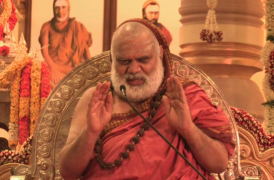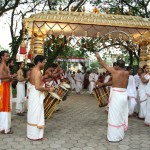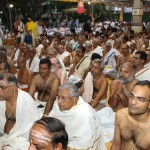
Chennai: JULY 1-4, 2012
Arrival at Sudharma
On the evening of July 1 2012, Jagadguru Shankaracharya Sri Sri Bharati Tirtha Mahaswamiji started from Raja Annamalai Puram, Chennai and arrived at Sudharma to a grand welcome by a large congregation of devotees. Here, the 100 year old heritage home of the Late Sri A. Sivasailam, an ardent devotee of the Mahaswamiji, would be the abode of the Jagadguru during the Chaturmasya Vrata. Ardent disciple, younger brother of Late Sri A. Sivasailam and Chairman of the Chennai Vijaya Yatra Committee, Sri A Krishnamoorthy offered Dhuli Pada Puja.
The public function to welcome the Jagadguru began with a Veda Ghosha. Sangeetha Saraswati Dr. Sudha Raghunathan rendered the prayer song, singing the composition, “Sharada Karunanidhe” composed by the 34th Acharya of the Peetham, Jagadguru Sri Chandrashekhara Bharati Mahaswamiji. Vidwan Goda Venkateshwara Shastri welcomed the Jagadguru in Sanskrit.
Sri A Krishnamoorthy then welcomed the Jagadguru by reading the Swagata Patrika in Tamil. He also remembered the various visits of the Sringeri Jagadgurus to Sudharma ; the first one being in 1960 when Jagadguru Sri Abhinava Vidyatirtha Mahaswamiji had stayed for 10 days, and his father Sri Anantaramakrishna Iyer of M/s Amalgamations Group had the fortune of serving the Jagadguru. His elder brother, Sri A. Sivasailam along with others had the fortune of welcoming Sri Sri Mahasannidhanam and Sri Sri Sannidhanam in the late 1970s and in 1986, and also during Sri Sri Sannidhanam’s 1995 Vijaya Yatra to Chennai. Sri A Krishnamoorthy ended the welcome with prayers that, by the Satsankalpa of the Jagadguru, the people of Chennai develop greater faith and devotion in God and the Guru.
Sri B. Madhavan, Secretary of the Madras Sanskrit College in his address recalled the dictum, “दर्शनादेव साधवः” and “तीर्थीकुर्वन्ती तीर्थाणि” from the Puranas that state that all fortune dawns by the mere Darshan of saints and that even the holy places are made holier by the dust of saints.
Blessing the gathering with His Anugraha Bhashanam, the Jagadguru said that Jagadguru Sri Adi Shankaracharya protected Sanatana Dharma and expounded the Dharma Tattva to everyone. In our Dharma, we have the system of Varnashrama – having the four Varnas and the four Ashramas. Thhe four Ashramas are Brahmacharyam, Garhasthyam, Vanaprastha and Sannyasa. There was a time when the fourth Ashrama – the Sannyasa Ashrama – had become rare. Before the time of Sri Adi Shankaracharya, it had become very rare to come across a Sannyasi. Sri Adi Shankaracharya brought about a change and revived the Sannyasa Ashrama. One of the Names in the Ashtottara Shata Namavali of Sri Adi Shankaracharya is परिव्राजाश्रमोद्धर्ता Parivraajaashramoddharta – one who revived the Sannyasa Ashrama.
The Jagadguru explained that Sanyasa Ashrama is ideal for a person who wants to attain Jnana or knowledge. In the other Ashramas, one has to perform a number of Karmas. It is not easy to pursue the path of knowledge in these Ashramas. Hence when one accepts Sannyasa, one can give up Karma in accordance to the scriptures, renounce the world and have the opportunity to engage solely in efforts toward attaining Jnana. Sri Adi Shankara Bhagavatpada hence embraced Sannyasa, and also gave Sannyasa to the qualified thus revived this Ashrama.
The Jagadguru pointed out that the Dharma Shastra texts including the Manu Smriti talk of the four Ashramas and the Dharma associated with them. The most important Dharma associated with Sannyasa Ashrama is Ahimsa.
Even though Ahimsa is classified as a Dharma common to all in accordance to the dictum – अहिंसा सत्यमस्तेयं शौचमिन्द्रियनिग्रहः । एतं सामासिकं धर्मं चातुर्वर्ण्येऽब्रवीन्मनुः ॥, it has special significance for a Sannyasi. The vow of Ahimsa is taken at the time of embracing Sannyasa – अभयं सर्वभूतेभ्यो मत्तः स्वाहा । Let all beings be freed of fear from me. Hence a Sannyasi avoids moving around during the rainy season as doing so may amount to harming many small living beings that emerge during the rains. The Sannyasi remains in one place for this time period. This is called as Chaturmasya. The Sankalpa taken during the Chaturmasya Vrata explains the observance of such Ahimsa as the very reason for observing the Chaturmasya. Hence the Chaturmasya period is set aside for staying in one place, for contemplation on the Brahma Tattva and for instructing eligible disciples.
The Jagadguru said that while He preferred to remain in Sringeri during Chaturmasya, He had set out on the Vijaya Yatra this year and had to observe it outside Sringeri in this Nandana year. Many ardent disciples had requested to conduct the Chaturmasya at their cities. However, He had chosen Chennai as it was fifty-two years before ago that His Guru had observed Chaturmasya in Chennai and the disciples of this city had been longing for the Sringeri Acharya to observe Chaturmasya here.
The Jagadguru also mentioned that while He preferred the bliss of solitude, the study of Sri Adi Shankaracharya’s Bhashyas, and in engaging in Japa, He was carrying out the responsibility entrusted by His Guru, and felt it was His duty to satisfy the sincere request of devotees. Hence He had preferred a peaceful location for observing Chaturmasya and acceding to the requests of the devotees of Chennai, had informed Sri A Krishnamurthy about His decision during the Alwarkurichi camp in May 2012.
The Jagadguru also expressed that that devotees and disciples streamed in to have the Darshan of their Acharya, to listen to His words, to receive His blessings, and they were prepared to travel long distances merely to have His Darshan. The Jagadguru empathized with the difficulties experienced by the devotees coming in to have His Darshan, and blessed them.
The Jagadguru also noted that the current year’s Chaturmasya’s period would be an extended one stretching into 3 months due to the Adhika Bhadrapada Maasa, and said that He would deliver Upanyasas regularly for the benefit of disciples.
The Jagadguru also fondly remembered that it was exactly forty-six years ago, on July 1 1966 that He had reached Ujjain to surrender at the Lotus Feet of His Guru. The Jagadguru ended His Anugraha Bhashanam stating that securing eveyone’s welfare was His daily prayer to Bhagavan, and blessed that everyone have Shraddha in Dharma and live as a Dharmika.
Photos
Vyasa Puja and Chaturmasya Sankalpa
Jagadguru Shankaracharya Sri Sri Bharati Tirtha Mahaswamiji undertook the Chaturmasya Vrata Sankalpa after performing the Vyasa Puja at Sudharma, Mylapore, Chennai.
The Chaturmasya began on the Poornima (full moon day) in the month of Aashaada Maasa, which fell on July 3, 2012. Also called ‘Guru Poornima’, on this sacred day, worship is offered to Brahma Vidyaacharyas – the great luminaries of hoary antiquity, who through their Supreme grace, have bestowed the knowledge of Brahman – Brahma Vidya – through a long, continuous and uninterrupted line of Acharyas.
The day is also called “Vyasa Poornima” and the Puja performed is titled “Vyasa Puja”. In our Guru Parampara that originates from Ishwara Himself, Bhagavan Veda Vyasa is held with the highest esteem by all followers of Sanatana Dharma. Bhagavan Veda Vyasa has brought about everyone’s welfare by classifying the Vedas into four, by crystallizing the messages of the Upanishads in His Brahma Sutras, and by penning the great epic Mahabharata as well as the eighteen Puranas. Sri Shuka, Sri Gaudapada and Sri Govinda Bhagavatpada kept the light of the Parampara burning. Then came the Great Master Sri Adi Shankaracharya, who revived Sanatana Dharma and spread it far and wide throughout Bharata Varsha.
In the course of the Vyasa Puja, the Jagadguru offered worship to three groups of Acharyas, each group consisting of five Acharyas. The first Puja was for Krishna Panchakam: Bhagavan Sri Krishna and the four Rishis, namely Sanaka, Sanandana, Sanatkumara and Sanatsujata. Bhagavan Sri Krishna is placed in the centre and the others to the east, south, west and north of Bhagavan. The Jagadguru offered worship with Sri Krishna Astottara Shatanama Archana. In the second Puja for Vyasa Panchakam, the Jagadguru worshipped Bhagavan Veda Vyasa. His idol was placed in the centre and His four disciples namely Sumanthu, Jaimini, Vaishampayana and Paila. The third Puja performed by the Jagadguru was for Acharya Panchakam: Sri Adi Shankara Bhagavatpada and His four shishyas, namely, Padmapadacharya, Sureshwaracharya, Totakacharya and Hastamalakacharya.
After the Pujas, the Sringeri Jagadguru Parampara Stotra was recited and the Jagadguru offered worship offered to the Guru Parampara beginning from Lord Sadashiva to Bhagavan Veda Vyasa to Sri Adi Shankaracharya to all the illustrious Acharyas who gracefully adorned the Sringeri Sri Sharada Peetham up to Jagadguru Sri Sri Abhinava Vidyatirtha Mahaswamiji.
The Jagadguru then took the Chaturmasya Sankalpa in accordance to the Shastras. To this, the disciples prayed in chorus promising that they will serve the Guru in accordance to the Shastras and requesting Him to stay comfortably at the location of Chaturmasya. On 4th July, the Jagadguru performed Uttara Puja in the morning.
























































